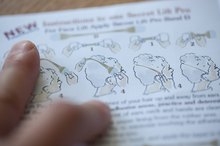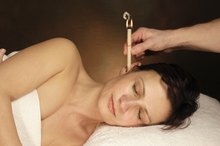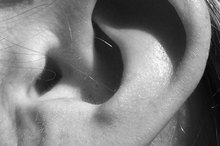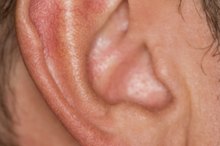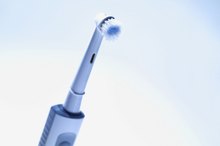How to Keep a Hearing Aid From Falling Out of the Ear
Ideally you should be able to wear your hearing aid, forget about it and never have to worry about it falling out of your ear. Some behind-the-ear hearing aids and mail-order hearing aids use a foam or silicone insert—attached to the hearing aid—to fit inside your ear. These types of inserts come in generic sizes and are more likely to fall out of your ear. However, with patience and a little trial and error, you can find a generic ear piece size that will comfortably stay in your ear. Custom fit hearing aids are made using a silicone impression or laser scan or your ear; this process produces a hearing aid that should fit down in your ear canal--unable to fall out.
If you are experiencing serious medical symptoms, seek emergency treatment immediately.
Make sure you are inserting the hearing aid properly 1. Custom made hearing aids need to be inserted into the correct ear; normally you'll find a red mark on the right hearing aid and a blue mark on the left hearing aid. When properly inserted, the ear piece will sit flush in your ear canal; larger hearing aids should be flush with your outer ear lobe—not protruding out past your ear lobe. You should feel your ear piece slide in place--down inside your ear canal. If you do not feel the hearing aid go in place, or if it feels funny or uncomfortable, take your hearing aid out and try again.
How to Use Instant Face-Lift Tape
Learn More
Have someone check your hearing aid, after you've put it on, to make sure it's flush with your outer ear and looks like it's in your ear properly. You can also use a mirror to check; the key is to do a visual check to make sure your hearing aid looks properly inserted.
Refer to your owner's manual or contact your hearing health care provider's office for instructions on properly inserting your hearing aid. Most hearing aid user guides have step by step instructions—with pictures—on how to properly insert your hearing aid. Set up an appointment at your hearing aid provider's office and have a specialist go over proper insertion with you.
How to Put on a Knee Brace Properly
Learn More
Determine when your hearing aid is falling out: is it during a certain activity or time of day? Sometimes you'll be sure you put your hearing aid in properly, and later in the day it's falling out of your ear. A hearing aid or ear mold can be loose in your ear canal. As you move throughout the day, chewing, talking and bending can cause ill-fitted hearing aids to pop out or fall out of your ear.
Do not put up with an ill-fitted hearing aid. Hearing aids and ear molds come with manufacturer's warranties. If your hearing aid is still under warranty—usually two to three years after purchase—make an appointment with a hearing aid provider selling the same brand of hearing aid you own. A new ear impression or scan may be necessary to re-fit your hearing aid. Even when out of warranty, you can get a hearing aid re-fitted for about $300.
Try different sizes or styles of ear pieces until you find the best fit. If you're wearing a hearing aid with a changeable foam or silicone dome ear piece, you may need a different size tip to stop your hearing aid from falling out of your ear. A dome that is too large will be hard to insert and will slowly move out of your ear canal throughout the day. A dome that is too small will slide in easily; but if you bend over or shake your head from side to side, the dome will come out of your ear. You can get a variety of different sized ear buds from your hearing aid manufacturer or hearing aid provider. Refer to your owner's guide for how to replace the foam or dome on your hearing aid.
Get new hearing aids or ear molds if your current set is over five years old. After years of wearing a hearing aid, your ear canal begins to change. Your ear canal gets larger and stiffer. This is why a hearing aid that fit your ear so well for years could now start falling out of your ear. Hearing aids and ear molds need to be replaced every five to seven years. If you enjoy the hearing you receive from your device, you could just have a new casing or shell made; if you wear a behind-the-ear device, you could just have your ear mold replaced.
Tips
If you're wearing a hearing aid using foam tips, the tips need to be replaced every two to three weeks. Silicone domes need to be replaced every four to six months.
Earwax build up could be pushing your hearing aid out of your ear. Have your physician check for earwax.
Weight gain or loss--as little as seven to 10 pounds--can change the fit of your hearing aid.
Warnings
Don't try using tape or glue to keep your hearing aids in place. The chemicals in adhesives aren't good for your skin or your hearing aids.
Hearing aids are expensive. If you put off fixing a hearing aid that keeps falling out, you may eventually lose your hearing aid.
Related Articles
References
Tips
- If you're wearing a hearing aid using foam tips, the tips need to be replaced every two to three weeks. Silicone domes need to be replaced every four to six months.
- Earwax build up could be pushing your hearing aid out of your ear. Have your physician check for earwax.
- Weight gain or loss--as little as seven to 10 pounds--can change the fit of your hearing aid.
Warnings
- Don't try using tape or glue to keep your hearing aids in place. The chemicals in adhesives aren't good for your skin or your hearing aids.
- Hearing aids are expensive. If you put off fixing a hearing aid that keeps falling out, you may eventually lose your hearing aid.
Writer Bio
In the hot desert of Arizona, Nadia Benavidez has been studying hearing instrument science since 2002. After leaving a clinical practice, Benavidez has put her talent to work writing informative articles related to health and wellness. Currently Benavidez is working on her first book.
